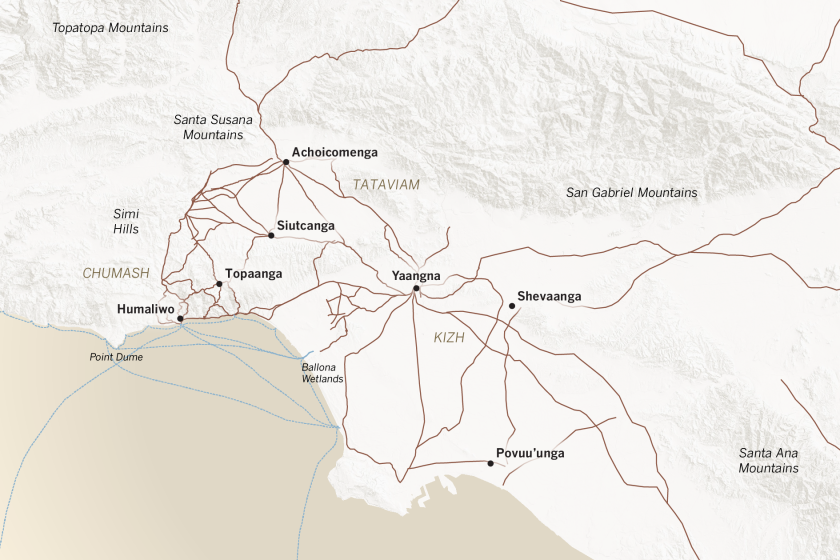
- Share via
The word “unprecedented” has become as much a definition of Donald Trump’s persona as jury verdicts, broken marriages and red baseball caps. All of which leaves many wondering about our country, institutions and Constitution: What are the consequences when the federal government reaches beyond the limits placed upon it for nearly 250 years? What happens when the checks and balances that the people placed on the government atrophy? Where does that leave us; where does it leave the most vulnerable of us?
Ask a Native American.
Native Americans have been living uneasily under just such a regime of overreach for well over a century. Beginning in the 1880s (although its roots were in place much earlier) the Supreme Court developed the Plenary Power Doctrine in federal Indian law.
The ‘Mapping Los Angeles Landscape History’ project seeks to illustrate major Los Angeles-area Indigenous settlements.
To understand the doctrine, and how it speaks to our current moment, it is necessary to reflect on the era of its birth. The late 19th and early 20th centuries were a time of rapid expansion for the United States. Native Americans, and their claims to land and sovereignty, stood in the way. In order to solve this “Indian problem” Washington sought to destroy tribes and tribalism. It was an effort buoyed by moneyed interests who wanted to profit from tribal resources, and by religiously minded folks who wanted to “save” Native peoples by radically altering their ways of life. Among other efforts, Native children were taken from their homes and shipped to boarding schools, tribal peoples were punished for engaging in cultural practices or even speaking their own languages, and tribal land and resources were appropriated and disrupted, resulting in devastating land loss and poverty.
How did the federal government justify these exercises of power over a vulnerable population? Certainly not through any of the channels you might have learned about in a civics class. Rather, a combination of might-makes-right and a claim to its inherent superiority begat the Plenary Power Doctrine. A triumvirate of government, the wealthy and self-righteous Christians were not about to let anything as trifling as the rule of law or the Constitution get in the way of their goals.
Native Americans throughout the University of California system are calling out scholars who claim Indigenous heritage without evidence and demanding action from campuses that hire them.
The first major “plenary power” Supreme Court case illustrates this point. In 1885 Congress passed the Major Crimes Act, legislation that purported to extend federal criminal jurisdiction over major crimes committed by one Native person against another on tribal lands. Recall that in 1885 there were only 38 states and tribal nations maintained significant, if dwindling, land holdings. Thus, the Major Crimes Act was akin to the U.S. passing a law asserting jurisdiction when, say, one Canadian citizen assaulted another Canadian citizen in Canada.
In 1886, a case challenging the constitutionality of the Major Crimes Act reached the Supreme Court: U.S. vs. Kagama. Government lawyers, with not much else to cling to, claimed that the commerce clause of the U.S. Constitution — which authorizes Congress to regulate commerce “with the Indian tribes” — provided the necessary justification for the Major Crimes Act, a criminal law statute.
“If they are permitted to murder each other,” the argument went,” it is certainly an interference with intercourse; because the number with whom intercourse will be held is thereby diminished.”
The aggregate data about Native identity is baffling. The real answers are found in conversations with individuals.
The Supreme Court, in rejecting this reasoning, called the government’s rationale a “very strained construction” of the commerce clause. And yet, that was not the end of the case. The court in Kagama announced that the federal government actually did have the authority to pass the Major Crimes Act, despite the lack of constitutional authority. Why?
“These Indian tribes are wards of the nation…. From their very weakness and helplessness, so largely due to the course of dealing of the federal government with them … there arises the duty of protection, and with it the power.”
In short, the limitations on power imposed by the Constitution simply didn’t matter because the federal government decided that it needed this authority. And what is the scope of plenary power? The government lawyers in their Kagama brief describe it this way:
“There is no limitation upon the power of Congress to enact whatever laws may be necessary to regulate the affairs of the Indian tribes.”
After suppression of Indigenous cultural burning, the state agrees Northern California’s Karuk Tribe may practice the burns more freely than it has in over 175 years.
The Plenary Power Doctrine remains in effect; it has even been judicially strengthened. In the 19th century, the Supreme Court justices at least admitted that the thin constitutional argument of the commerce clause didn’t really apply. In our 21st century, the court has stated point blank that “the Constitution grants Congress broad general powers to legislate in respect to Indian tribes, powers that we have consistently described as ‘plenary and exclusive.’ ”
Why isn’t there more awareness of this virtually unlimited, now constitutionally sanctioned authority over Native America? Likely because plenary power is a double-edged sword, and for the last handful of decades it has been used more to benefit Native America than to harm it, resulting in things such as the Indian Self-Determination and Education Assistance of 1975 and similar legislation. But if history is our guide, this can and will change. And in this particular moment, when a lot of things in the United States are changing for the worse, the state of federal Indian law offers a cautionary tale.
One need not strain to hear the echoes of the past speak to us today. Native peoples know from experience that power without guardrails is coercion, and that it can reshape a people and their nation with devastating consequences. Not for the first time, an emboldened leadership, a small group of greedy brokers and religious zealots are putting to the test the United States’ commitment to its foundational principles. What happened and is happening to Native Americans proves that the incongruent can quickly become irrefutable if these forces are not adequately resisted.
Let’s root out plenary power in Indian law and keep it from taking hold more broadly.
Keith Richotte Jr., a citizen of the Turtle Mountain Band of Chippewa Indians, is the director of the Indigenous Peoples Law and Policy Program and a law professor at the University of Arizona. His latest book, “The Worst Trickster Story Ever Told: Native America, the Supreme Court and the U.S. Constitution.”
More to Read
Insights
L.A. Times Insights delivers AI-generated analysis on Voices content to offer all points of view. Insights does not appear on any news articles.
Viewpoint
Perspectives
The following AI-generated content is powered by Perplexity. The Los Angeles Times editorial staff does not create or edit the content.
Ideas expressed in the piece
- The Plenary Power Doctrine originated in the late 19th century as a tool to justify federal overreach over tribes, framed as a paternalistic “duty of protection” but rooted in racial superiority and economic interests in acquiring tribal lands[4].
- Congress’s authority under the doctrine is untethered to explicit constitutional text, relying instead on Kagama v. United States (1886), which rejected the Commerce Clause as a basis but asserted federal power over tribes due to their “weakness and helplessness”[4][6].
- The doctrine has enabled destructive policies, including forced assimilation (e.g., boarding schools), land dispossession, and suppression of cultural practices, under the guise of federal oversight[4].
- While modern legislative efforts like the Indian Self-Determination and Education Assistance Act (1975) have used plenary power to support tribal governance, the doctrine remains constitutionally dubious and susceptible to abuse if political priorities shift[4].
Different views on the topic
- Some legal scholars argue that plenary power is necessary to uphold federal treaty obligations and protect tribal sovereignty from state encroachment, as states historically sought to invalidate tribal jurisdiction over lands and resources[2][6].
- The Supreme Court’s recent engagement with plenary power in cases like Haaland v. Brackeen (2023) signals potential judicial willingness to reevaluate the doctrine’s scope, particularly through critiques by justices like Gorsuch[1][3].
- Critics acknowledge that tribes retain inherent sovereignty unless expressly limited by Congress, and that plenary power does not negate tribal self-governance but instead coexists with it under the trust relationship[5][6].
- Proponents of congressional authority argue that judicial intervention risks undermining tribal autonomy further, as courts historically lack expertise in tribal affairs compared to politically accountable branches[3][5].
A cure for the common opinion
Get thought-provoking perspectives with our weekly newsletter.
You may occasionally receive promotional content from the Los Angeles Times.










